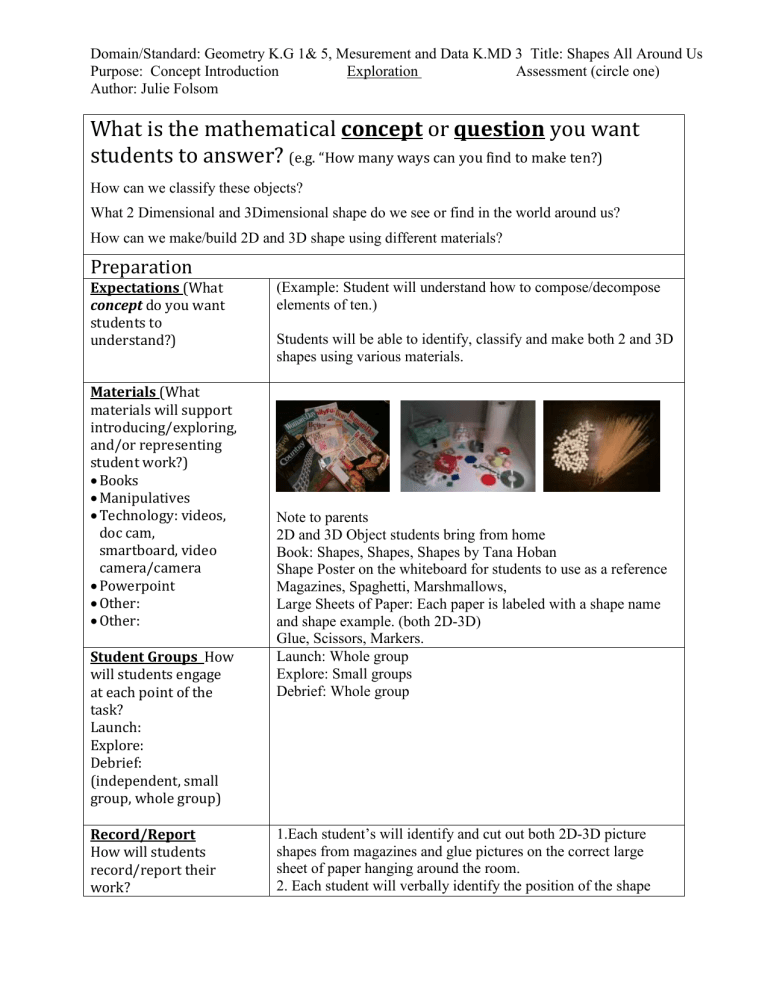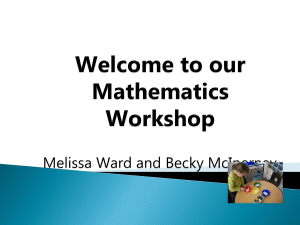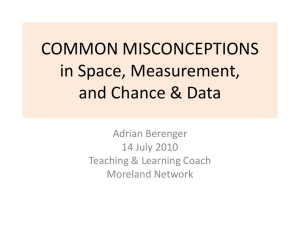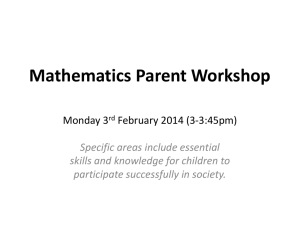question - CCAK52012

Domain/Standard: Geometry K.G 1& 5, Mesurement and Data K.MD 3 Title: Shapes All Around Us
Purpose: Concept Introduction Exploration Assessment (circle one)
Author: Julie Folsom
What is the mathematical concept or question you want students to answer?
(e.g. “How many ways can you find to make ten?)
How can we classify these objects?
What 2 Dimensional and 3Dimensional shape do we see or find in the world around us?
How can we make/build 2D and 3D shape using different materials?
Preparation
Expectations (What
concept do you want students to understand?)
(Example: Student will understand how to compose/decompose elements of ten.)
Students will be able to identify, classify and make both 2 and 3D shapes using various materials.
Materials (What materials will support introducing/exploring, and/or representing student work?)
Books
Manipulatives
Technology: videos, doc cam, smartboard, video camera/camera
Powerpoint
Other:
Other:
Student Groups How will students engage at each point of the task?
Launch:
Explore:
Debrief:
(independent, small group, whole group)
Record/Report
How will students record/report their work?
Note to parents
2D and 3D Object students bring from home
Book: Shapes, Shapes, Shapes by Tana Hoban
Shape Poster on the whiteboard for students to use as a reference
Magazines, Spaghetti, Marshmallows,
Large Sheets of Paper: Each paper is labeled with a shape name and shape example. (both 2D-3D)
Glue, Scissors, Markers.
Launch: Whole group
Explore: Small groups
Debrief: Whole group
1.Each student’s will identify and cut out both 2D-3D picture shapes from magazines and glue pictures on the correct large sheet of paper hanging around the room.
2. Each student will verbally identify the position of the shape
Domain/Standard: Geometry K.G 1& 5, Mesurement and Data K.MD 3 Title: Shapes All Around Us
Purpose: Concept Introduction Exploration Assessment (circle one)
Author: Julie Folsom
(oral, written, pictorial, pair-share, doc-cam, etc.) they will bring to the whole group discussion/debriefing at the end of the activities/tasks.
LAUNCH:
present the task (problem)
How will you introduce student/s to the task?
(varies upon purpose of task:introduction of concept, exploration, or assessment) e.g. Story, video, build background, discussion of past experience, etc.)
Parent Note: Students will be asked to bring common household objects that are examples of 2 dimensional and 3 dimensional shapes.
Before we look at the objects the student bought in read the book shapes, shapes, shapes by Tana Hoban
Next look at the objects the students brought from home-
How can we classify these objects?
Classify/sort the objects by shapes;1 st
by 2 or 3D, 2 nd
by specific shape.
Present the task:
State the mathematical question.
How can we classify these objects?
What 2 Dimensional and 3Dimensional shape do we see or find in the world around us?
How can we make/build 2D and 3D shape using different materials?
EXPLORE
( invite children to solve on their own in multiple ways)
How will students explore the task?
(What activities provide access to all students while maintaining the cognitive demands of the task?)
As students work independently or in small groups, what questions will you ask to—
help a group get started or make progress on the task?
focus students’ thinking on the key mathematical ideas in the task?
assess students’ understanding of key mathematical ideas, problem- solving strategies, or the representations?
advance students’ understanding of the mathematical ideas?
How will you ensure that students remain engaged in the task?
What assistance will you give or what questions will you ask a student (or group) who
Domain/Standard: Geometry K.G 1& 5, Mesurement and Data K.MD 3 Title: Shapes All Around Us
Purpose: Concept Introduction Exploration Assessment (circle one)
Author: Julie Folsom
What will you do if a student (or group) finishes the task almost immediately?
How will you extend the task so as to provide additional challenge? become quickly frustrated and requests more direction and guidance in solving the task?
Activity: 1. In small groups; Students will look at magazines to find pictures of both 2 and 3 dimensional shapes which they will cut out and glue to a large paper that identifies each shape.
(ie. Squares, circles, triangles, rectangles, hexagons, cubes, spheres, cones and cylinders)
2.Each student will find a picture /shape that they can share with the class; The student should be able to identify the object and the shape it represents as well as describe the relative position of that object.(above, below, beside, in front of, behind, and next to)
Engagement Questions: What shape are you going to look for first?
What kinds of objects have that shape?
Is that shape 2-D or 3D?
What picture are you going to share with the class?
Can you identify the position of your object?
Activity: 1.
In small groups: Students will make/build 2 and 3 dimensional shapes using spaghetti and marshmallows. You can limit the shapes the students build. (squares, triangles, rectangles, hexagons, cubes, cones and cylinders)
Domain/Standard: Geometry K.G 1& 5, Mesurement and Data K.MD 3 Title: Shapes All Around Us
Purpose: Concept Introduction Exploration Assessment (circle one)
Author: Julie Folsom
Engagement Questions: What shape will you make first?
How many sides or vertices does that shape have?
Are the sides the same length or different lengths?
Are the materials easy or hard to use? Why?
What shape do you think will be the hardest to make/build?
DEBRIEF/DISCUSS
(engage children in mathematical discourse in which they share and “argue” about their problem-solving strategies)
How will you orchestrate the class discussion so that you accomplish your mathematical goals?
Which solution paths do you want to have shared during the class discussion?
In what order will the solutions be presented? Why?
What specific questions will you ask so that students will—
1.
make sense of the mathematical ideas that you want them to learn?
2.
expand on, debate, and question the solutions being shared?
3.
make connections among the different strategies that are presented?
4.
look for patterns?
5.
begin to form generalizations?
What will you see or hear that lets you know that all students in the class
understand the mathematical ideas that you intended for them to learn?
Whole group discussion/debrief: 1. On the board have the position words written on the whiteboard.(to be used for the last shape activity) Students bring one picture to the whole group; student should be able to identify the object and the shape it represents as well as describe the relative position of that object.(above, below, beside, in front of, behind, and next to)
Start: Students think about how did we classify these objects and what was your favorite math task/activity today? Move into small groups on the rug and take turns sharing your answers to the questions? (3-5 minutes depending on the students engagement and on task discussion)
Next: Call on a few students to share how their group answered the questions
Wrap up: Each student briefly shares the picture/shape they brought to whole group they should identify the object and the shape it represents as well as describe the relative position of that object.(above, below, beside, in front of, behind, and next to)
Domain/Standard: Geometry K.G 1& 5, Mesurement and Data K.MD 3 Title: Shapes All Around Us
Purpose: Concept Introduction Exploration Assessment (circle one)
Author: Julie Folsom







